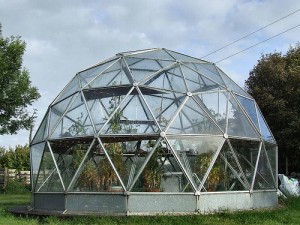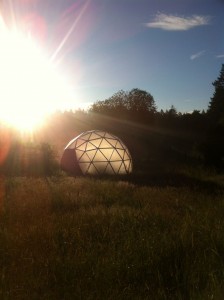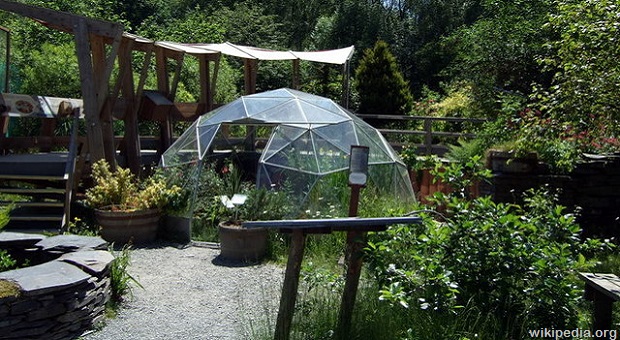A geodesic dome looks much like a ball cut in half. Due to its shape, the dome is durable and reliable. They are built to use maximum space while using the least amount of surface area. One benefit of the dome is that it allows the most amount of light to hit all points of the structure, unlike many other greenhouses which may have shady spots or hot spots. This structure also allows plenty of room for vertical growing.
While this is a superior type of greenhouse, there is one that is even more beneficial and it’s called the biodome.
Biodome
While biodomes come in the same shape as a geodesic dome, they are actually much better in a number of ways and the two shouldn’t be confused.
{adinserter backyardliberty}Biodomes are self contained ecosystems which are controlled to closely resemble a natural environment. An example of this is at the Montreal Biodome in which there are four different ecosystems that visitors can explore.
One is based on the South American rainforest, one on the North American wilderness, one on an estuary, and the last one on a polar area that has been divided into an Arctic side and a Antarctic side. This is done by keeping the inside of the biodome precisely controlled.
A biodome, once established, is able to be self sufficient and regenerate its own water and nutrients. There is no need for outside intervention once it is set up and running. However, the purpose of a biodome as a garden is to create the perfect environment for growing your own food source. Biodomes, when built large enough, can also play host to insects and animals.
 The benefits of owning a biodome are many and various. Using a biodome for growing food means you can have the perfect temperature and ‘season’ all year long. Unlike a traditional greenhouse, cucumbers and lettuce in the winter are no problem, and neither is cantaloupe in the spring.
The benefits of owning a biodome are many and various. Using a biodome for growing food means you can have the perfect temperature and ‘season’ all year long. Unlike a traditional greenhouse, cucumbers and lettuce in the winter are no problem, and neither is cantaloupe in the spring.
They save money when it comes to water and energy because the inside of the biodome is regenerative. When using a biodome to grow food, it is easy to determine the exact amount of growing time each different vegetable will need, giving growers the ability to plan exactly when to plant and harvest, making it easy to have enough of any given vegetable at any given time.
Seedlings that are grown in a biodome grow faster than those grown in a hot bed or by other methods. They are not only stronger, but more resilient as well. They can survive being transplanted to a garden easier, if sharing your plants with neighbors, friends, or family is something you’re considering. Biodomes are also good at keeping out bugs and viruses plants can become sick with. The biodome is designed to keep these things out.
The outside of the biodome works much like the geodesic dome in that the sun will not overheat one area or be affected by shade. Plants don’t dry out or even get too much or too little of any given nutrient.
For those who are interested, the biodome can be used for both aquaponics and also for hydroponics. Biodomes are typically a little larger than other types of greenhouses, so in addition to being able to control the environment, there are many more options of how to use the biodome, some of which aren’t possible in one of the more conventional greenhouses. If space is an issue, a smaller sized biodome will work just as good as a large one.
When biodomes are built correctly, they can withstand a variety of environmental factors. Because of the way the biodome is structured, it is very strong and can withstand a lot of pressure. It is best if they are screwed in and bolted down to the ground, so they can even withstand small tornadoes and earthquakes. Many biodomes are builder friendly with simple construction and overall can be more cost effective than many greenhouses.
 Biodomes, once unscrewed or unbolted from the ground, are portable and easy to move. Because of this, many cities and towns don’t require building permits as they are considered temporary structures, although it is important to check local building codes.
Biodomes, once unscrewed or unbolted from the ground, are portable and easy to move. Because of this, many cities and towns don’t require building permits as they are considered temporary structures, although it is important to check local building codes.
Biodomes have superior ventilation and are energy efficient due to their shape. Since heat rises, many greenhouses will stay hotter near the top.
With a biodome, the heat rises to the top, then naturally gets pushed down as more heat keeps rising, keeping the dome the same temperature year round.
A small window inserted at the top of the biodome allows excess hot air to vent, while the vent at the base of the biodome allows cold air in. This exchange keeps the air moving and continually fresh, making the inside of the biodome the perfect place to grow a variety of vegetables.
As people begin to realize how to get back to doing things the way they were for years, there is naturally a learning curve. Whether it’s learning to hunt, can, or even sew, it all takes time. Using a biodome to grow vegetables can decrease the learning curve exponentially when it comes to gardening and a family can be up and running with fresh produce in no time. As time and money are factors for many people, the biodome may be the perfect answer for families.
Biodomes are used by many people in countries all over the world, with great success. As times become harder, money tighter, and dependency on the grid ever more frightening, doing more things for ourselves becomes even more important. Learning about using heirloom seeds in the biodome can help to keep a garden up and running for years to come. Having a garden is a big step in being self sustaining, and knowing where the food is coming from.
Gardeners determine what chemicals come in contact with the food, whether or not to use GMO seeds, and other factors. Fresh, healthy produce is readily available year round, making the biodome the best option for most people.
This article has been written by Susan C. for Survivopedia.






















































































Great article! That said, I have built an aquaponic system inside the machine shed, complete with lights, as there is very little available natural light in the shed. I’m growing trout and in the bed have Swiss Chard.
I’m not exactly sure as to how it happened but I now have an aphid infestation. I’ve purchased 1000 ladybugs to help fight the infestation but they can’t keep up to the aphids.
Do you have any idea at to how I can get rid of these aphids? Am I at a point where I need to start over with the bed?
I’m thinking I should start a new bed 10 or 12 feet away from the infested one and completely remove the infested plants and medium in the original bed.
The best way to safely kill aphids is to put 3 or 4 drops of very fine sewing machine oil in a 8 oz spray bottle filled with water and shake it up. Spray the aphids, the oil will cause the water to penetrate the aphid body and drown it. It won’t harm you or your plants.
A few years back we had aphids on our roses and tomatoes. Initially, we used a spray with hot pepper oil. We got it at Home Depot. I don’t know if it’s still available. After that, we just planted marigolds in the area, and this has worked well with the pests. I’m not sure how well they will grow in your shed!
Neem oil… in the largest percentage (of the solution).
In regards to the Bio Dome as well as the aphids, I live in Tucson where we have the Biosphere II, an experimental establishment based on Biosphere I (earth). When visiting it for the first time, the thing that most stuck with me was the fact, that in recreating the forest, they discovered that limbs could not support themselves – no strength. The gardeners, not the academic brains, then figured out that the strength and resilience came from the wind and installed fans to blow the branches. As to the aphids and other pests, not having their natural enemies in the environment, allows the aphids to multiply even quicker. As to the ladybugs – good move but the adult ladybug is not as ferocious an eater as it its larvae. Also allow for the fact that your number of aphids, not having any enemies, not even wind and water to dislodge at least some of them during their life cycle, gives the aphid cart blanch. I doubt that moving the bed will make a difference – the aphid has wings, just use neem (as suggested) or soapy water to get on top of the problem.
Can a biodome house a colony or 2 of bees for pollination, and if so, would that keep them from becoming “africanized”?
Sandra, there is no way your bio-dome could support a colony of bees. You could of course have a behive next to it and allow the bees to enter yet not make it their exclusive source of pollen and nectar. Might be possible by having a pipe which you can close and open go into the dome for a brief time that you need pollinization. I wouldn’t worry about africanization of your hives. It’s not something thast happens all that often. I don’t know where you live, but if it happens, it’s mostly in milder climates where swarms can be mated by the african bees.
Most of the gardening catalogs have yellow sticky traps for insects. The bugs like light, eg the yellow sun, so they go for them. Place them just above your crop in the horizontal position, so the bugs can see them better. They can be caught in a yellow dishpan with soapy water in it also. Probably you have too much nitrogen in the soil, according to the Encyclopedia of Natural Insect & Disease Control. Test your soil, add some wood ashes and phosphate.
Another trick I’ve seen is to just use yellow paper and coat it with Vaseline. Bugs like white flies – and hopefully aphids – are drawn to the color and then get stuck in the petroleum. Good luck!
Just read your biodome article & surfed around the web a bit looking for a kit or instructions to build one for my system before I set it up in Wisconsin. I did find an interesting link that I would like to share about planning and building a green house that is loaded with information. It also has a page about pest control but it didn’t mention aphids, but it did have more links embeded for more info. It’s a dot.com site and this is the link. http://nuagri.com/planning-and-building-a-greenhouse/
Very nice article, but nothing was said about where to get a Bio Dome. Do you have any info on their availability. I would like to look into getting one.
It has it’s links embedded near the bottoms of the various pages, but I would think one of them would lead to a standard kit link. My search was for info to build it my self, and I end that session early to report back on the aphid control question under the controlling pests link, sorry. I too would like more info on the dome design, ie… Are the triangle uniform through out? That would make it’s construction a whole lot easier in calculating the base requirements.
In our dome we use Praying Mantis to control Aphids.
How does one protect a geodesic dome from marauders? Is there some system of bars that can be installed to protect the glass?
HI
CAN ANYONE TELL ME ,T SUBSTANCES DO LANTS NEED TO GROW? WHAT WILL ANTS CONTRIBUTE TO HE BIODOME? THANK YOU